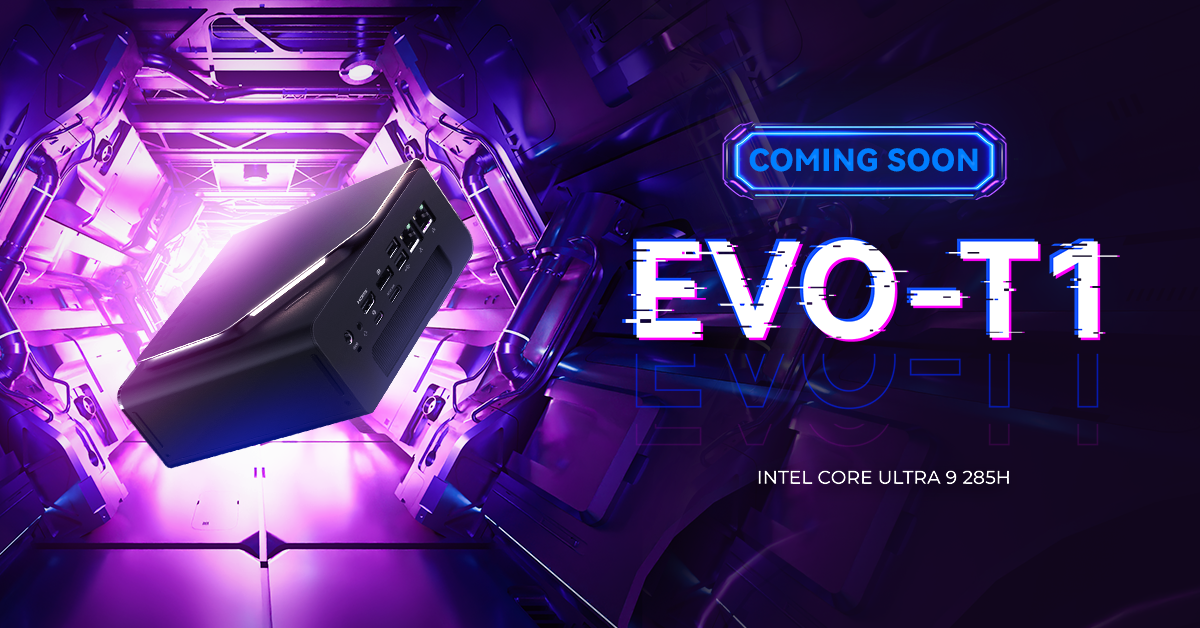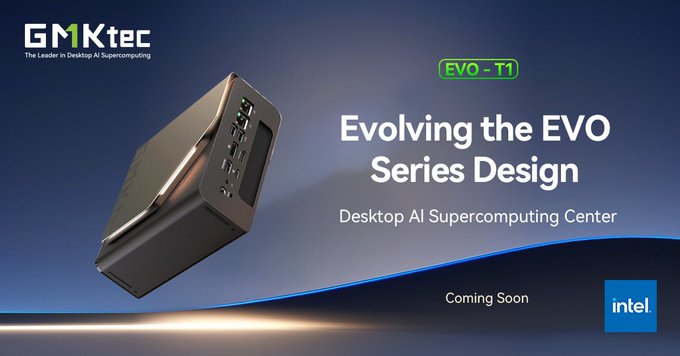GMKTec EVO T1 Review: Intel's Core Ultra 9 Beast in a Box
The mini PC market is heating up, and GMKTec is fanning the flames with its latest release. Enter the GMKTec EVO T1, a small form-factor powerhouse that redefines what we can expect from a compact machine. It’s not just another incremental upgrade; this device is powered by Intel's cutting-edge Core Ultra 9 285H processor, paired with the surprisingly potent integrated Arc 140T iGPU. This combination promises desktop-level performance for productivity, content creation, and even serious gaming. In this deep-dive review, we’ll unpack everything the GMKTec EVO T1 has to offer, from its robust port selection and OCuLink support to its real-world performance, to help you decide if this is the mini PC you've been waiting for.
Table of Contents
- What's Included in the Box?
- Design, Ports, and Features
- How to Open and What is Upgradable?
- A Tweaker's Dream: Unlocked BIOS
- Windows, Benchmarks, and Video Playback
- The Curious Case of the USB 4.0 Speed Issue
- 4K Video Editing Performance
- Gaming Performance: 1080p and 4K
- Thermals and Fan Noise
- Linux Support
- Final Thoughts: Pros & Cons
- Frequently Asked Questions (FAQ)
What's Included in the Box?
GMKTec provides a comprehensive package to get you started right away. Inside the box, you'll find the GMKTec EVO T1 unit itself, a VESA mounting bracket with the necessary screws for attaching it to the back of a monitor, a quality HDMI cable, and the power supply. Speaking of the power supply, it’s a modern and compact 148.2W unit that likely uses GaN technology, keeping it from being a bulky brick on your desk—a thoughtful touch for a mini PC setup.
Design, Ports, and Features
The first thing you'll notice about the GMKTec EVO T1 is its size. While marketed as a mini PC, it leans more towards a Small Form-Factor (SFF) PC. It’s a bit larger than many of its predecessors, but that extra space is put to good use for superior cooling and expansion. The build quality is solid, with a stylish alloy top plate and a durable plastic chassis.
The port selection is simply phenomenal. On the front, you have a power button with a status LED, a CMOS reset pinhole, three USB 3.2 Gen 2 (10Gbps) Type-A ports, a full-spec USB-C port, and a 3.5mm audio combo jack. The back is even more impressive, hosting the DC power-in, another audio jack, a full-spec USB4 port (40Gbps), an OCuLink port (63Gbps) for eGPUs, two USB 2.0 ports, a DisplayPort 1.4, an HDMI 2.1 port, a Kensington lock slot, and not one, but two 2.5 Gigabit Ethernet LAN ports. This extensive I/O makes the EVO T1 incredibly versatile for any setup.
How to Open and What is Upgradable?
Getting inside the GMKTec EVO T1 is straightforward. By removing the four rubber feet (which are screws), you can access the internals. The design is user-friendly, allowing easy access to the system fans for cleaning. To dive deeper, removing four more screws lets you lift the mainboard out. This is where the upgrade potential truly shines.
The review unit came with a massive 64GB of DDR5 SODIMM RAM and a 1TB PCIe 4.0 SSD. Inside, you'll find an incredible three M.2 PCIe 4.0 slots in total, meaning you can add two more NVMe SSDs for a huge amount of ultra-fast storage. The RAM is also fully upgradable, as are the two SODIMM slots. The Wi-Fi 6 card can also be swapped out, perhaps for a future Wi-Fi 7 module, making this a highly future-proof machine.
🚀 GMKtec × Intel Interview Drop!
— gmktecofficial (@gmktecdotcom) June 8, 2025
Introducing EVO-T1 — a 64GB AI mini PC co-designed with Intel.
💡 Why 64GB? Why now?
Intel’s GM: “This was always part of our roadmap.”
🔗 Watch the future of AI unfold.#GMKtec #Intel #EVO_T1 #MiniPC #AI #CoreUltra pic.twitter.com/VyJ4RpasBW
A Tweaker's Dream: Unlocked BIOS
For PC enthusiasts, the EVO T1's BIOS is a major highlight. It is almost completely unlocked, offering deep customization over RAM timings, power limits, and other advanced settings. The most practical feature for most users is the ability to switch power profiles. You can choose between "Balanced" (around 54W), "Quiet," and "Performance." The Performance mode unleashes the Core Ultra 9 285H, allowing it to draw between 70-80W for maximum power. You can also dedicate a significant portion of system RAM (up to 32GB on a 64GB model) to the Arc 140T iGPU, which is fantastic for graphics-intensive tasks.
Windows, Benchmarks, and Video Playback
The EVO T1 ships with Windows 11 Pro, a welcome inclusion over the standard Home edition. Performance benchmarks are impressive. The single-core score exceeds 3,000 points in some tests, showcasing the raw speed of the new architecture. Multi-core performance is competitive with high-end chips from previous generations, despite having fewer threads (16 cores, 16 threads). Graphics scores are where the Arc 140T shines, with Time Spy scores over 4,000, placing it well ahead of older integrated solutions. Video playback is flawless, easily handling 4K high-bitrate H.265 and VP9 content without breaking a sweat.
The Curious Case of the USB 4.0 Speed Issue
While the GMKTec EVO T1 gets so much right, it's not without its quirks. During testing, I encountered a frustrating and random issue with the USB4/Type-C ports. When transferring large files from a high-speed external SSD, the speed would start strong at over 1.4 GB/s but then inexplicably plummet to around 300-400 MB/s. There were no disconnections, but the performance drop is significant and inconsistent. This seems to be a recurring software or firmware issue with some GMKTec models that I hope gets addressed in a future BIOS update, as it's the main blemish on an otherwise stellar device.
4K Video Editing Performance
Thanks to the powerful CPU and the Arc 140T's excellent media engine with Intel Quick Sync, 4K video editing in Adobe Premiere Pro is a breeze. The timeline is smooth and responsive, even with basic edits and transitions on 4K footage. Export times are where this mini PC truly excels. A one-minute 4K project exported in a blistering 22 seconds. This level of performance was once reserved for desktops with dedicated GPUs, making the EVO T1 a viable and compact solution for content creators.
Gaming Performance: 1080p and 4K
The Mini PC with Intel Core Ultra 9 285H is a legitimate gaming machine. The Arc 140T iGPU delivers performance that punches well above its weight class.
1080p Gaming
In demanding titles, the EVO T1 holds its own. In The Witcher 3 at 1080p on low settings, it consistently hovered around a smooth 60 FPS. For Cyberpunk 2077, the built-in benchmark yielded an average of 43.8 FPS on the low preset, which is very playable. This demonstrates that you can enjoy modern AAA titles comfortably at 1080p.
4K Gaming
To really push its limits, I tested GTA V: Enhanced Edition at 4K resolution with High settings. Amazingly, the EVO T1 managed a stable 38-40 FPS. While not 60 FPS, this is an incredible feat for an integrated GPU at such a high resolution and quality preset, proving its capability for lighter or older titles even in 4K.
Thermals and Fan Noise
With up to 80W of power in a compact chassis, cooling is critical, and GMKTec has nailed it. Under sustained full load from gaming and benchmarks, the CPU temperature peaked at a very reasonable 82-84°C. There was no significant CPU core throttling, only some minor throttling on the "ring" component, which didn't impact real-world performance. The fan noise is also well-managed; it's audible under load but not intrusive or high-pitched. Here's a sample:
Linux Support
For Linux users, the experience is a mixed bag out of the box. I tested Manjaro, and while the system ran, the Intel Wi-Fi 6 card was not detected, requiring a manual driver search or workaround. However, both 2.5GbE LAN ports worked perfectly. As with many new hardware releases, Linux support will likely improve as kernel and driver updates roll out, but be prepared for some initial tinkering.
Final Thoughts: Is the GMKTec EVO T1 Worth It?
The GMKTec EVO T1 is an ambitious and largely successful mini PC. It delivers outstanding performance thanks to the Intel Core Ultra 9 285H and Arc 140T graphics, making it a true desktop replacement for many users, including gamers and content creators. Its excellent cooling, vast port selection, and incredible upgradeability are major selling points.
However, it's held back by some frustrating flaws. The inconsistent USB4 port speeds and my inability to get the OCuLink port working (despite many hours of troubleshooting) are significant issues that cannot be ignored. If GMKTec can resolve these with a firmware update, the EVO T1 would be an almost perfect machine. As it stands, it's a powerhouse with a few asterisks.
Pros
- Incredible CPU and iGPU performance
- Excellent cooling system, no thermal throttling
- Fantastic port selection, including dual 2.5GbE and OCuLink
- Highly upgradable with 3x M.2 slots
- Unlocked BIOS for enthusiasts
- Great 1080p gaming and 4K video editing capabilities
Cons
- Inconsistent and sometimes slow USB4/Type-C speeds
- OCuLink did not work during testing (potential unit or driver issue)
- Wi-Fi may require workarounds on Linux
- Premium price point starting at $899
Frequently Asked Questions (FAQ)
Is the GMKTec EVO T1 good for gaming?
Yes, it's one of the best mini PCs for gaming right now. It can handle modern AAA games at 1080p with low to medium settings and older titles even at 4K, thanks to its powerful Arc 140T iGPU.
Can I upgrade the RAM and SSD in the EVO T1?
Absolutely. It has two standard SODIMM slots for DDR5 RAM and an impressive three M.2 PCIe 4.0 slots for NVMe SSDs, making it one of the most expandable mini PCs on the market.
Does the OCuLink port work for eGPUs?
While it features an OCuLink port designed for high-speed eGPU connections, I was unable to get it to function correctly during my extensive testing. This could be a driver, BIOS, or unit-specific issue, but it's a significant concern for those buying it specifically for that feature.
.jpg)


Comments
Post a Comment